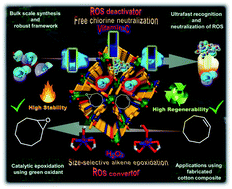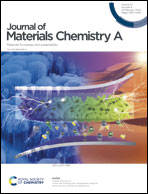In situ fabricated MOF–cellulose composite as an advanced ROS deactivator-convertor: fluoroswitchable bi-phasic tweezers for free chlorine detoxification and size-exclusive catalytic insertion of aqueous H2O2†
Abstract
Combining the merits of structural diversity, and purposeful implantation of task-specific functionalities, metal–organic frameworks (MOFs) instigate targeted reactive oxygen species (ROS) scavenging and concurrent detoxification via self-calibrated emission modulation. Then again, grafting of catalytically active sites in MOFs can benefit developing a greener protocol to convert ROS generators to technologically important building blocks, wherein tailorable MOF-composite fabrication is highly sought for practical applications, yet unexplored. The chemo-robust and hydrogen-bonded framework encompassing free –NH2 moiety affixed pores serves as an ultra-fast and highly regenerable fluoro-probe for selective detection of toxic ROS producers hypochlorite ion (ClO−) and H2O2 with record-level nanomolar sensitivity. While the bio-relevant antioxidant L-ascorbic acid (AA) imparts notable quenching to the MOF, a significant 3.5 fold emission enhancement with bi-phasic colorimetric variation ensues when it selectively scavenges ClO− from uni-directional porous channels through an unprecedented molecular tweezer approach. Apart from a battery of experimental evidence, density functional theory (DFT) results validate “on–off–on” fluoroswitching from redistribution of MOF orbital energy levels, and show guest-mediated exclusive transition from “Tight state” to “Loose state”. The coordination frustrated metal site engineered pore-wall benefits the dual-functionalized MOF in converting the potential ROS generator H2O2via selective alkene epoxidation under mild-conditions. Importantly, sterically encumbered substrates exhibit poor conversion and demonstrate first-ever pore-fitting-induced size selectivity for this benign oxidation. Judiciously planned control experiments in combination with DFT-optimized intermediates provide proof-of-concept to the ionic route of ROS conversion. Considering an effective way to broaden the advanced applications of this crystalline material, reconfigurable MOF@cotton fiber (CF) is fabricated via in situ growth, which scavenges free chlorine and concomitantly squeezes it upon exposure to AA with obvious colorimetric changes over multiple real-life platforms. Furthermore, multi-cyclic alkene epoxidation by MOF@CF paves the way to futuristic continuous flow reactors that truly serves this smart composite as a bimodal ROS deactivator-convertor and explicitly denotes it as an advanced promising analogue from contemporary state-of-the-art materials.



 Please wait while we load your content...
Please wait while we load your content...